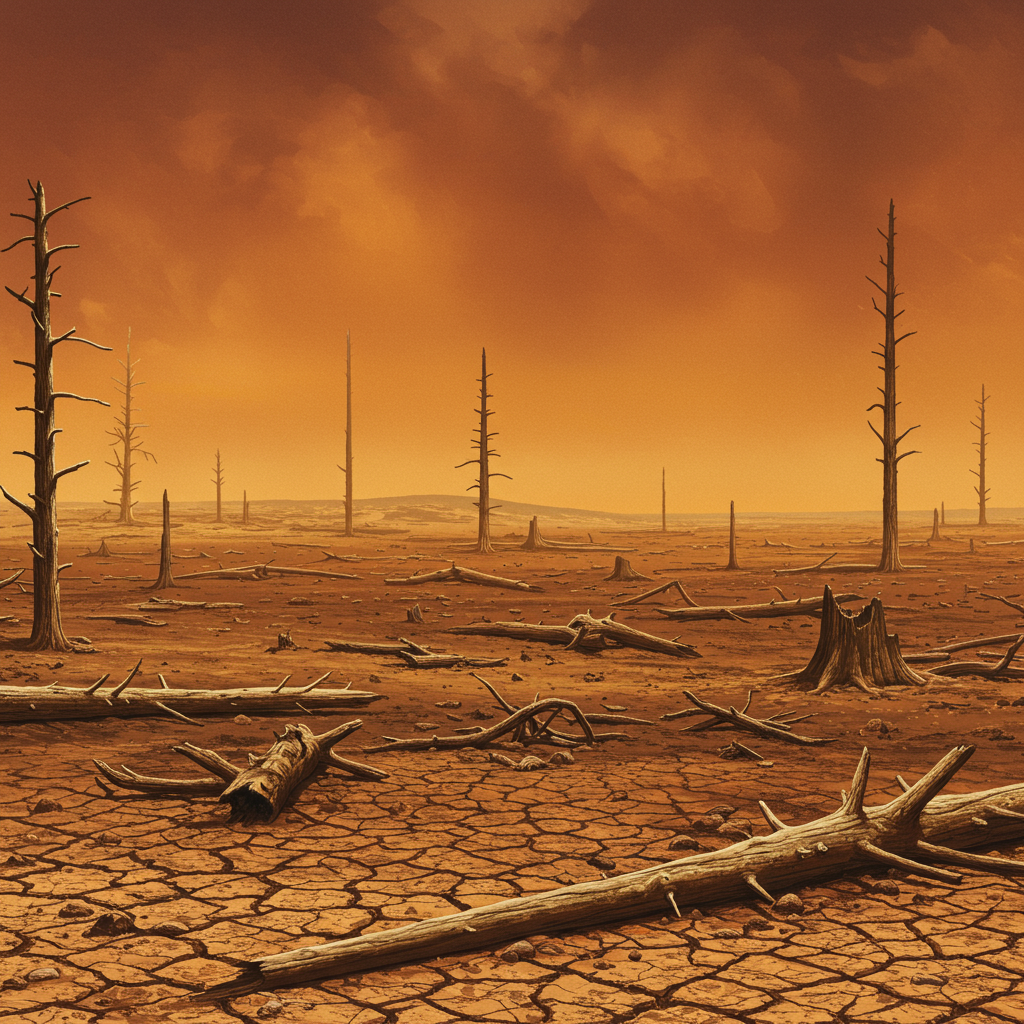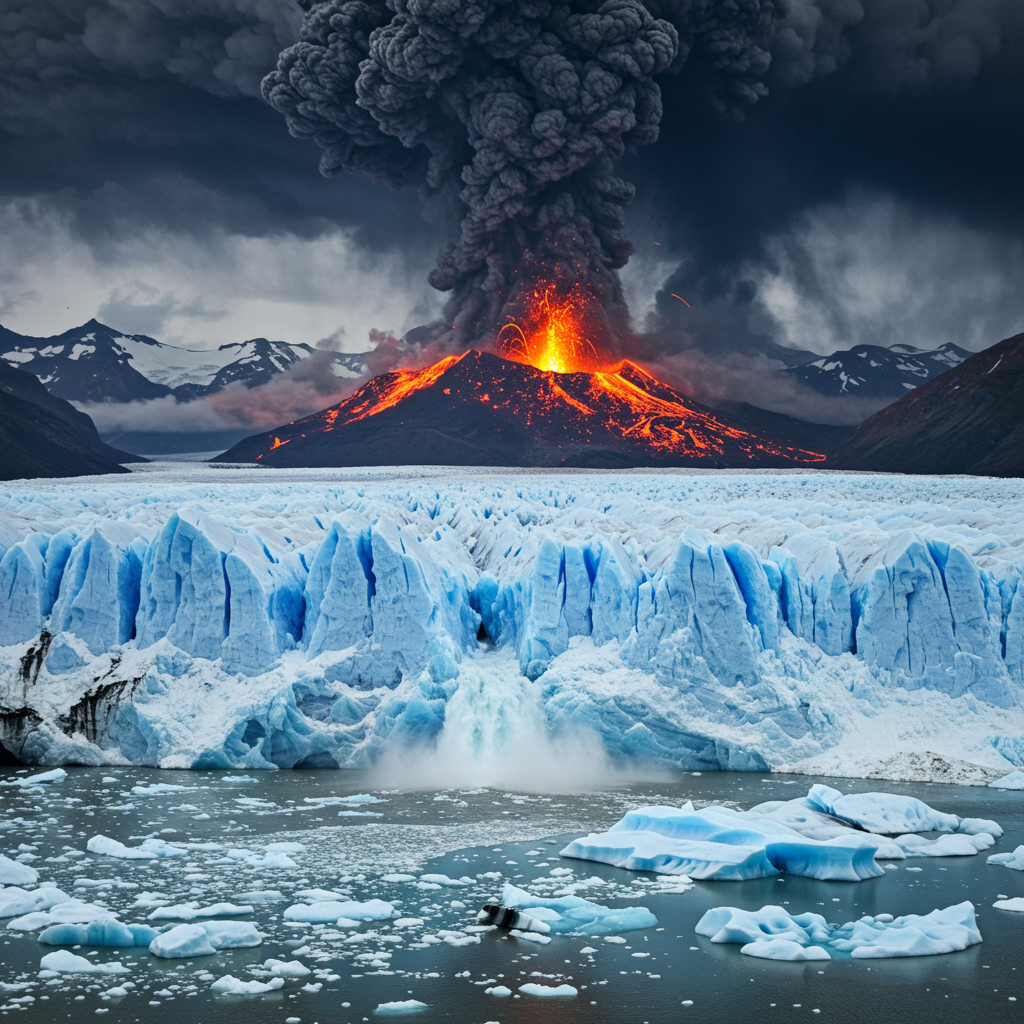Around 252 million years ago, life on Earth faced its ultimate test. The Permian–Triassic mass extinction, famously dubbed “The Great Dying,” stands as the most horrific environmental collapse in our planet’s lengthy history. During this cataclysm, a staggering 94% of marine species and 70% of land-dwelling vertebrate families vanished forever. Lush tropical forests, vital for soaking up atmospheric carbon and regulating global temperatures, were decimated. Scientists have long agreed that a massive surge in greenhouse gases triggered this event, sparking intense and rapid global warming. Yet, a profound mystery lingered: why did these scorching hot conditions persist for an astonishing five million years?
Earth’s Inferno Begins: The Siberian Traps Eruption
The fuse for the Great Dying was lit by an immense volcanic event in what is now Siberia. Known as the Siberian Traps, these eruptions spewed colossal amounts of molten rock across the landscape. Crucially, this rock flowed over a sedimentary basin exceptionally rich in organic matter and volatile compounds like coal and gas.
The intense heat from the magma didn’t just melt rock; it baked the surrounding organic sediments. This process released staggering quantities of carbon dioxide (CO2) and other greenhouse gases into the atmosphere. This happened over a geologically rapid period – potentially as short as 50,000 years, though perhaps spanning up to 500,000 years.
Rapid Warming and Global Collapse
This sudden, massive influx of CO2 acted like a thermal blanket, trapping heat and causing Earth’s temperature to skyrocket. This rapid temperature increase is considered the primary mechanism behind the widespread death and extinction.
On land, surface temperatures may have soared by as much as 6°C to 10°C. For many life forms, evolution and adaptation couldn’t keep pace with such drastic, swift environmental change. While large volcanic events can disrupt climate, the Earth system usually recovers relatively quickly, typically within 100,000 to a million years.
However, following the Great Dying, conditions didn’t normalize. Average equatorial surface temperatures settled upwards of 34°C – roughly 8°C hotter than today’s equatorial average – and remained there for roughly five million years. This prolonged “super greenhouse” state was anomalous. What prevented Earth from recovering?
The Critical Role of Earth’s Forests
Scientists hypothesized that the rapid warming had a devastating effect on plant life, particularly dense tropical forests. Plants are the cornerstone of Earth’s organic carbon cycle. Through photosynthesis, they pull CO2 from the atmosphere and store it as organic matter in their tissues and the soil. Tropical and subtropical forests, with their high productivity and vast biomass, are especially efficient carbon sinks.
If these forests were wiped out, the planet’s capacity to remove CO2 from the air would be severely diminished. This could explain why CO2 levels, once elevated by the Siberian Traps, stayed high, locking Earth into that prolonged hothouse state. Plants, rooted in place, are uniquely vulnerable to rapid climate shifts.
Fossil Evidence Reveals Ecological Devastation
To test this hypothesis, researchers meticulously analyzed the fossil record of various land plant biomes across the globe, from arid scrublands to lush tropics. They examined fossil collections spanning the period just before the mass extinction to about eight million years after it.
The evidence was stark. Fossil reconstructions confirmed that tropical and subtropical forests, once abundant across the equatorial continents, were almost entirely wiped out by the extreme heat and environmental stress. This devastation is visible in the geological record as a multi-million year “coal gap.” Coal deposits form from the accumulation of organic matter, primarily from dense swampy forests. The absence of coal layers for millions of years following the Great Dying clearly indicates the collapse of these widespread forest ecosystems.
The complex, towering trees and rich peat bogs that characterized the pre-extinction tropical landscapes were replaced by much simpler, smaller vegetation. Fossil finds show landscapes initially dominated by tiny lycopods, plants resembling modern club mosses, standing only 2 to 20 centimeters tall.
A Slow, Uneven Recovery
Pockets of larger plant life survived in cooler refuges, such as higher latitudes (closer to the poles), coastal areas, and mountainous regions where temperatures were slightly less extreme. Research focusing on high-latitude sites, like the Sydney basin in ancient Gondwana (near the South Pole at the time), reveals the patchy and difficult path to recovery.
This research indicates plant recovery wasn’t a simple regrowth. It occurred in stages:
Initial hardy survivors like conifers appeared.
But even 2 million years after the extinction, a renewed period of intense warming caused a setback, replacing these early forests with tough, shrubby, clubmoss-like plants better suited to scorching conditions.
- It took millions more years for stable forest ecosystems to re-establish, dominated by new types of plants, like seed-bearing ferns, which were different from the pre-extinction flora.
- dailygalaxy.com
- theconversation.com
- theconversation.com
- news.climate.columbia.edu
- www.newscientist.com
While forests eventually returned after about five million years, the dominant plant types were generally less efficient at fixing carbon than the diverse ecosystems they replaced.
Trapped in the Hothouse: The Carbon Cycle Breakdown
This widespread collapse and slow, inefficient recovery of plant life had a direct impact on Earth’s climate system. Scientists estimated the “net primary productivity” (NPP) – the rate at which plants convert atmospheric CO2 into organic matter – for the different biomes observed in the fossil record. They found that global NPP plummeted after the extinction event.
Researchers then used a sophisticated carbon cycle model called SCION to simulate the effect of this reduced NPP. The model results were conclusive: the initial temperature increase caused by the Siberian Traps emissions was sustained for five to six million years precisely because the capacity of global ecosystems to absorb CO2 was drastically reduced. The planet remained locked in a super greenhouse state.
Earth only began to transition out of these extreme conditions gradually. As plant life slowly re-established itself and the organic carbon cycle began to regain some efficiency over millions of years, CO2 levels slowly declined, allowing temperatures to eventually ease.
Lessons from the Deep Past
Drawing direct comparisons between ancient climate change, which unfolded over tens or hundreds of thousands of years, and present-day changes, happening over decades and centuries, is complex. However, the Permian–Triassic extinction offers profound lessons.
It demonstrates that while life is remarkably resilient, there are limits. When massive environmental changes occur too rapidly – even over thousands of years, as in the Permian case – life’s ability to adapt or migrate is overwhelmed, leading to catastrophic collapse. Today’s climate change is happening orders of magnitude faster.
The study powerfully underlines the indispensable role of tropical and subtropical ecosystems, especially forests, in maintaining Earth’s climate equilibrium. Their destruction doesn’t just lead to species loss; it weakens the planet’s natural capacity to regulate its own temperature. The loss of these critical carbon sinks can act as a devastating climate tipping point, amplifying warming and potentially locking the planet into undesirable states for vast stretches of time.
Considering Earth’s history, the last time atmospheric CO2 levels consistently reached today’s 420 parts per million was around 14 million years ago – long before humans evolved during a period of much lower CO2 (270-280 ppm). The current trajectory is pushing the planet into conditions unprecedented in human history. The deep past serves as a stark warning: maintaining healthy, functioning ecosystems is not just about preserving biodiversity; it’s fundamental to sustaining a climate fit for complex life.
Frequently Asked Questions
What was the “Great Dying” and what caused this mass extinction event?
The “Great Dying,” or Permian-Triassic mass extinction, occurred about 252 million years ago and was the most severe extinction event in Earth’s history, wiping out up to 94% of marine species and 70% of land vertebrate families. It was primarily caused by massive volcanic eruptions in Siberia (the Siberian Traps), which released enormous amounts of greenhouse gases, mainly CO2, into the atmosphere over a geologically short period. This triggered rapid and intense global warming.
Where can scientists find fossil evidence of plant recovery after this extinction?
Fossil evidence of plant recovery is found in geological formations worldwide dating to the Early Triassic period, after the extinction. While many studies have focused on tropical regions showing widespread die-off and the “coal gap,” research in higher-latitude areas, such as the Sydney basin in Australia (which was near the South Pole at the time), provides unique insights into the multi-stage and uneven process of plant community re-establishment over millions of years following the environmental collapse.
How does the loss of forests millions of years ago compare to the potential impact of deforestation today?
The study on the Permian-Triassic extinction highlights how the large-scale collapse of forests, particularly tropical ones, severely hampered Earth’s ability to remove CO2 from the atmosphere, prolonging a hothouse climate for millions of years. While the scale and speed differ, modern deforestation also significantly reduces Earth’s capacity to absorb CO2, contributing to ongoing climate change. The ancient event serves as a powerful example of how disrupting vital plant ecosystems can amplify warming and push the climate system past critical tipping points, leading to long-lasting consequences.




